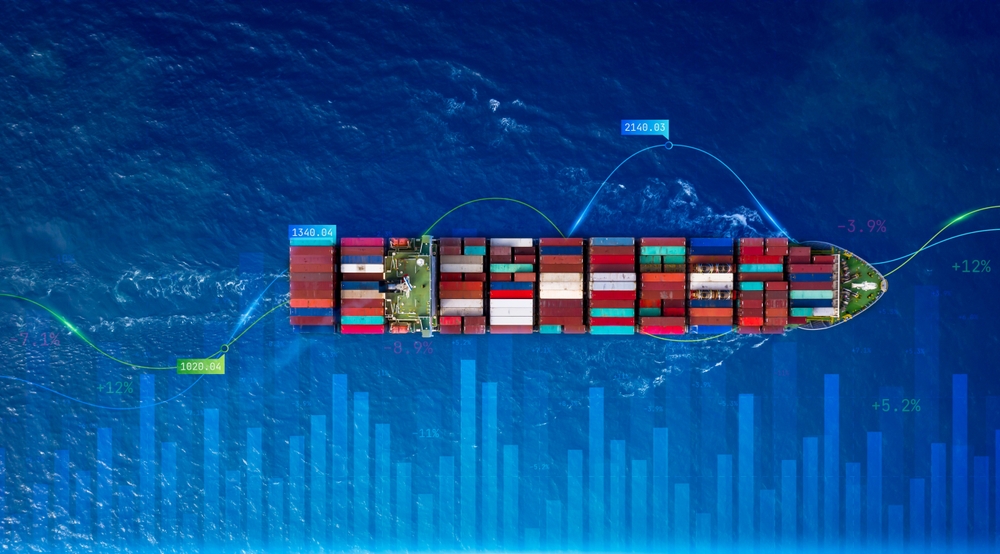GLOBAL MARITIME MARKET IN AUGUST 2025
August 2025 saw the global maritime market facing a complex reality: a clear divergence between key segments and ever-changing geopolitical challenges. This was not just a month of numbers, but a period of strategic restructuring and adaptation for the entire industry.
1. CONTAINER SHIPPING: OVERCAPACITY PRESSURE WEIGHS ON FREIGHT RATES
- August was a period when the container market continued to be under immense pressure, especially after the “frontloading” of goods ended. Key indices all reflected a sharp decline:
- SCFI and WCI: The Shanghai Containerized Freight Index (SCFI) recorded a decrease on the Europe (-4.1%), US West Coast (-3.1%), and US East Coast (-1.6%) routes in the last week of the month. Similarly, the Drewry World Container Index (WCI) fell 6% to $2,119 per FEU by the end of the month. Data from Xeneta also confirmed that spot rates on the Far East – US East Coast route had dropped 12.8% since the end of July.
- Root Cause: This downward rate pressure primarily stemmed from a global fleet overcapacity, forcing carriers to increase blanked sailings to curb the pace of rate decline. This indicates that supply dynamics are completely overwhelming demand dynamics, creating a fundamental imbalance in the market.
2. DRY BULK AND TANKER SHIPPING: CONTRADICTORY MOMENTUM
- While the container market “cooled down,” other segments showed an opposite picture:
- Dry Bulk Shipping: The Baltic Dry Index (BDI) rose to 2025 by the end of August. This growth was driven by a strong performance in the Capesize market, thanks to demand from miners and iron ore shipments. However, the long-term outlook remains weak due to a slowing Chinese economy and changes in U.S. trade policy.
- Tanker Shipping: This market had a mixed outlook. Crude tanker shipping is projected to have a balanced development due to OPEC+’s decision to increase oil production. Conversely, the product tanker segment is expected to weaken due to rapid fleet growth and shorter tonne-mile demand after the Panama Canal resumed normal operations.
3. GEOPOLITICAL CRISES & REGULATORY CHANGES: A DAILY RISK
- Geopolitical events and policy changes directly and continuously impacted the maritime industry in August:
- Red Sea Crisis: Following two serious Houthi attacks in July, the crisis escalated alarmingly. Although it created a “risk premium” on freight rates, this was not strong enough to counteract the fundamental downward trend in the container market . The crisis is expected to last until at least 2026, forcing businesses to re-evaluate their long-term supply chain strategies.
- U.S. Trade Regulation Changes: Effective August 29, the U.S. suspended the de minimis duty-free exemption for all countries, requiring every shipment, regardless of value, to undergo formal customs entry . Furthermore, the UFLPA has added five new sectors to the enforcement priority list, including lithium and copper, showing that U.S. trade policy is expanding its scrutiny to green energy supply chains .
- Wave of Environmental Regulations: New environmental rules continue to reshape the maritime industry. The IMO Net-Zero Framework, approved in April and expected to take effect in 2027, is the first legal framework to combine mandatory emissions limits with a carbon pricing mechanism . Other key regulations taking effect in 2025 include FuelEU Maritime, EEDI Phase 3, and the Hong Kong Convention on ship recycling.
4. TECHNOLOGY & RESILIENCE: A STRATEGIC COMPASS
- In the context of increasing risk, technology has become a strategic tool to build resilience. Businesses are prioritizing the use of integrated visibility platforms to reduce “blind spots” and detect disruptions early . The completion of the first electronic Bill of Lading (eBL) transaction in the U.S. was also a significant milestone, showing the industry is shifting towards digital systems to enhance transparency and reduce costs . The adoption of technologies like IoT and AI is not just for performance optimization but is a strategic response to geopolitical uncertainties .
In conclusion, August 2025 exposed a multi-layered and volatile maritime market. Managers and strategists need a comprehensive view, combining macroeconomic analysis with geopolitical and regulatory factors. For businesses, survival and growth will depend on their agility in adapting to changes, prioritizing digitalization, and investing in sustainable solutions.
Seafarer Club compiled from weekly market reports from Fearnleys, Star Asia, Xclusiv, Athenian, Banchero Costa, Alibra, Intermodal, SSY, Gibson, Affinity, Best Oasis, GSM, Breakway, Agora, and Helenic Shipping News.







